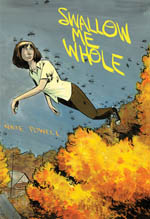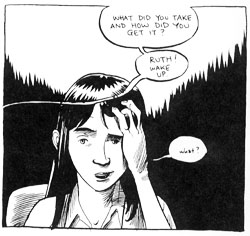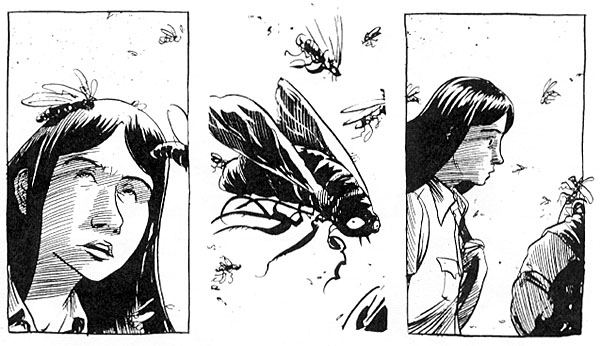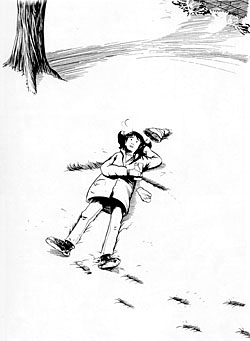 By Nate Powell
By Nate Powell
216 pages, black and white
Published by Top Shelf Productions
Looking at the cover of Swallow Me Whole, I’ll admit that my first reaction was one of unease. There’s something creepy about it, with the character of Ruth levitating around the treetops, with insects all around her body even as Ruth looks back over her shoulder. It took me a few minutes to realize what had struck me so much about it; Ruth doesn’t look so much like she’s flying, here, but rather as if she’s being carried away by someone or something beyond her control. It’s that lack of control that I think punctuates all of Swallow Me Whole, making Nate Powell’s graphic novel a journey to somewhere very uncomfortable.
 Ruth and Perry are both a little different than most teenagers. At an early age, both of them realized that no one else could see the things that each of them did, so they stopped telling their parents about them. But Ruth still has insects talk to her and occasionally pour out of the ceiling vent, while Perry’s art is often dictated by the commands of a little eraser in the form of a wizard. As they grow older, though, their visions are growing more intense and harder to ignore. And sooner or later, something in their life will have to give.
Ruth and Perry are both a little different than most teenagers. At an early age, both of them realized that no one else could see the things that each of them did, so they stopped telling their parents about them. But Ruth still has insects talk to her and occasionally pour out of the ceiling vent, while Perry’s art is often dictated by the commands of a little eraser in the form of a wizard. As they grow older, though, their visions are growing more intense and harder to ignore. And sooner or later, something in their life will have to give.
Swallow Me Whole is definitely one of the more unsettling books I’ve read this year. It’s that early scene where Ruth sees insects first crawl, then start pouring out of the vent that I actually started shivering in response. Because while there’s a lot going on in Swallow Me Whole—not just the hallucinations and other signs of schizophrenia, but family drama as well as the pressures of high school—it’s there that I think Powell really got an immediate emotional response out of me. There’s something particularly disturbing about the way that Powell writes his characters and how their mental impairments control their lives. What may seem innocent and ignorable early on becomes anything but as they get older, these mental creations almost dragging them through life at times. At the same time, I actually felt more than a little relieved that both siblings had these problems; in giving them confidants Powell lets the reader feel a little hope, a slight sense that things might not be quite so bad.

 The smaller details of Swallow Me Whole can almost get lost the first time through, what with the overpowering nature of Ruth and Perry’s mental condition. There’s a lot to take in, though, with the horribly off-kilter nature of Ruth’s teachers at school, for example, or the effect that caring for their very ill grandmother is having upon the entire family. They’re all part of the greater whole here, each part of the greater mosaic that Powell is creating. It’s an important piece of Swallow Me Whole in part because it makes the entire story feel much richer and realistic, but also because it gives a strange sense of hope about the entire book. For all of Ruth and Perry’s issues and problems, the world keeps moving forward and it makes you wonder if they can find a place in it. Seeing Ruth work at the museum, for instance, makes one start to think that things really can be all right in the end.
The smaller details of Swallow Me Whole can almost get lost the first time through, what with the overpowering nature of Ruth and Perry’s mental condition. There’s a lot to take in, though, with the horribly off-kilter nature of Ruth’s teachers at school, for example, or the effect that caring for their very ill grandmother is having upon the entire family. They’re all part of the greater whole here, each part of the greater mosaic that Powell is creating. It’s an important piece of Swallow Me Whole in part because it makes the entire story feel much richer and realistic, but also because it gives a strange sense of hope about the entire book. For all of Ruth and Perry’s issues and problems, the world keeps moving forward and it makes you wonder if they can find a place in it. Seeing Ruth work at the museum, for instance, makes one start to think that things really can be all right in the end.
Of course, a lot of the dramatic effect of Swallow Me Whole couldn’t have been achieved without Powell’s art. So much of the book’s power comes from being able to actually see Ruth’s hallucinations come to life; the look on her face when the locusts begin to appear, for instance, or how Memaw’s physical appearance melts into an earlier time as she talks. Ruth forever has that slightly gangly, young appearance about her that helps remind you that she’s just a high school student; it’s an important visual point to be made that this someone who still has so much else going on in her life in addition to her mental issues. If she’d looked more adult-like in Swallow Me Whole, it might have somehow made it easier to think that she would have the additional knowledge or fortitude to get through it all. (That’s not necessarily the case, of course, but that impression that age brings strength is there.) It’s also definitely worth checking out to see how Powell handles scenes at night or in shadow; the extra layers of ink do a great job of darkening the scene and cloaking its details, but without making it impossible to read or understand what’s going on. It’s a fine line to walk, but Powell succeeds well here.
It’s hard to talk about Swallow Me Whole without discussing the ending, but at the same time it’s a dramatic enough sequence that one definitely wouldn’t want it spoiled. So let me just say that it’s a nervy conclusion to the book from Powell, and one that certainly stop and think about what’s going on. To be honest, the more I think about it, the more I’m convinced that there really wasn’t any other way for Powell to end Swallow Me Whole. Anything more succinct or cut-and-dried really wouldn’t have fit with the rest of the book, and I’m glad Powell had the determination and ability to end it this like he did. After reading Swallow Me Whole I’m definitely ready to see more from Powell. It’s highly unsettling, but in the best possible way.
Purchase Links: Amazon.com
